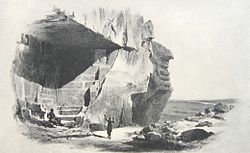Tura
| |
|---|---|
District | |
| Hayy Tura | |
 Depiction of a limestone quarry in Tura | |
| Coordinates: 29°56′45″N 31°19′05″E / 29.94583°N 31.31806°E | |
| Country | Egypt |
| Governorate | Cairo |
| Area | |
• Total | 25 sq mi (65 km2) |
| Population (2023) | |
• Total | 245,644 |
| Time zone | UTC+2 (EST) |
Tura (Egyptian Arabic: طرة Tora IPA: [ˈtˤoɾˤɑ], Coptic: ⲧⲣⲱⲁ, Ancient Greek: Τρωια or Τρωη[1]) was the primary quarry for limestone in ancient Egypt.[2] The site, which was known by the ancient Egyptians as Troyu or Royu, is located about halfway between modern-day Cairo and Helwan.[3] Its ancient Egyptian name was misinterpreted by the ancient Greek geographer Strabo, who thought it meant it was inhabited by Trojans, thus the Hellenistic city was named Troia.[4] The site is located by the modern town of Tora in the Cairo Governorate.[5]
The limestone from the quarry is thought to have been deposited during the late Lutetian stage of the Eocene epoch, about 42 million years ago. Some fossil fish species have been described from the quarry.[6][7]
- ^ Peust, Carsten. "Die Toponyme vorarabischen Ursprungs im modernen Ägypten" (PDF). p. 99.
- ^ Grimal, Nicholas. A History of Ancient Egypt. p. 27. Librairie Arthéme Fayard, 1988
- ^ Grimal, Nicholas. A History of Ancient Egypt. p. 111. Librairie Arthéme Fayard, 1988
- ^ Cite error: The named reference
Quarrieswas invoked but never defined (see the help page). - ^ Talbert, Richard. Barrington Atlas of the Greek and Roman World. p. 74. (ISBN 0-691-03169-X)
- ^ "PBDB". paleobiodb.org. Retrieved 2024-03-27.
- ^ White, Errol Ivor (1936). "V.— On certain Eocene percoid fishes". Annals and Magazine of Natural History. 18 (103): 43–54. doi:10.1080/00222933608655173. ISSN 0374-5481.
